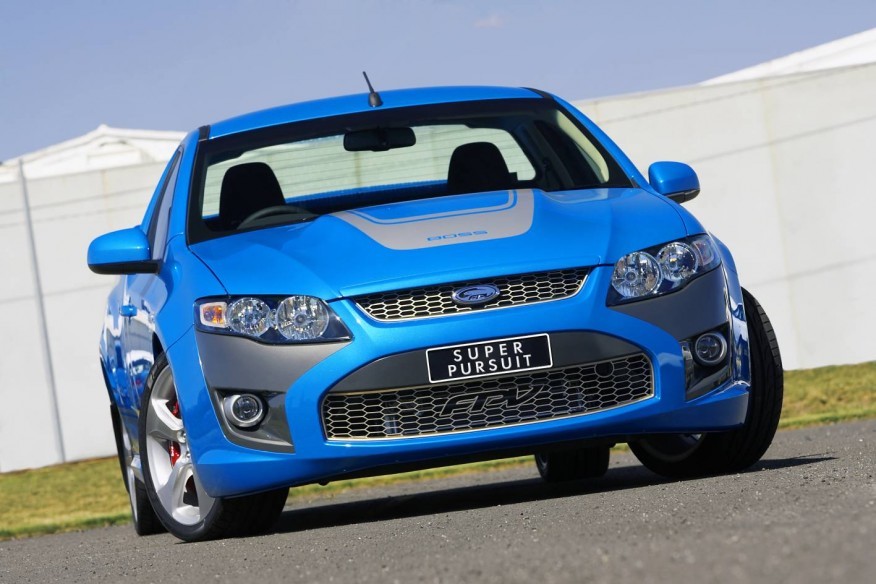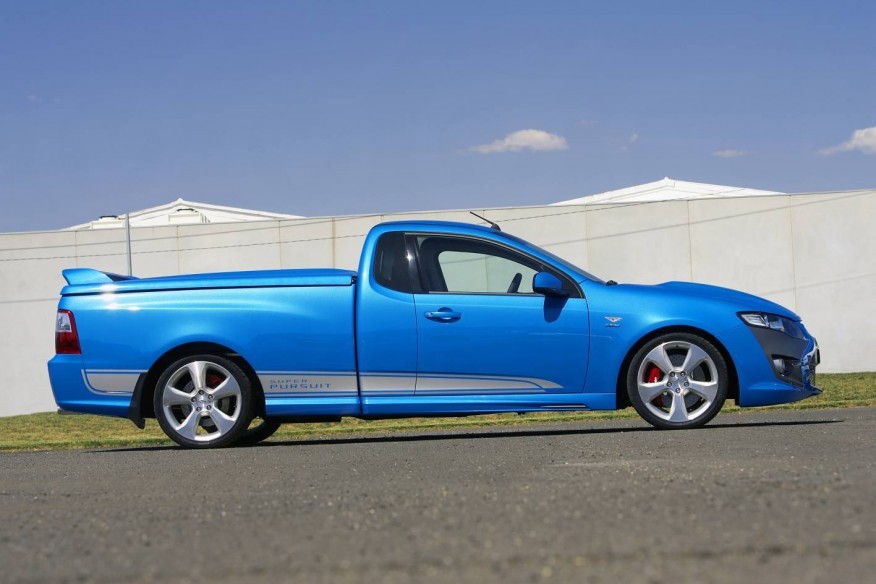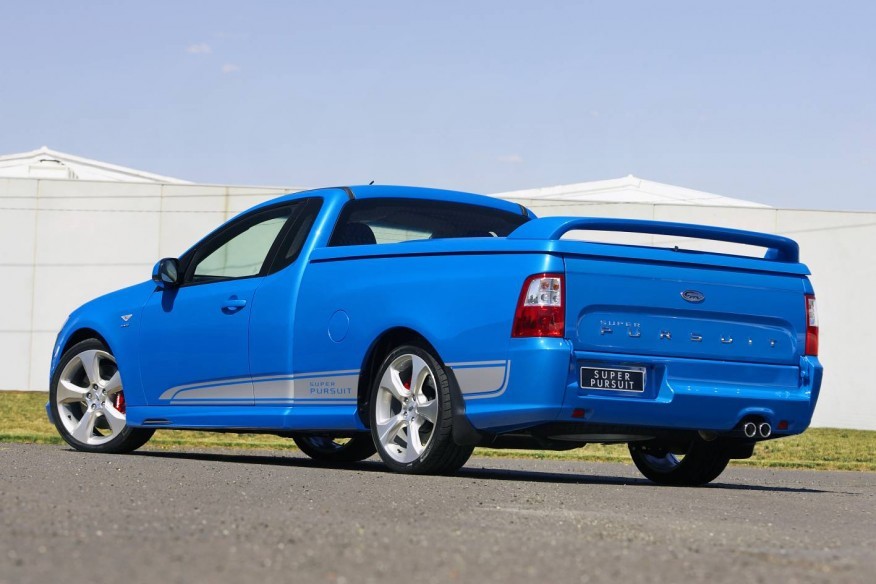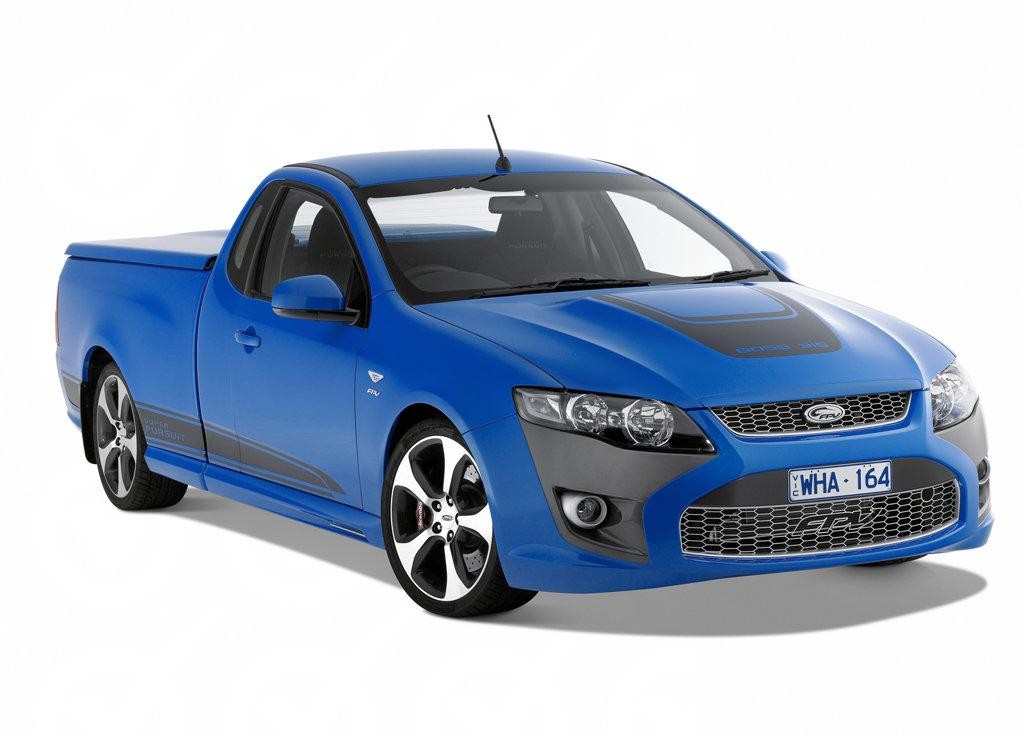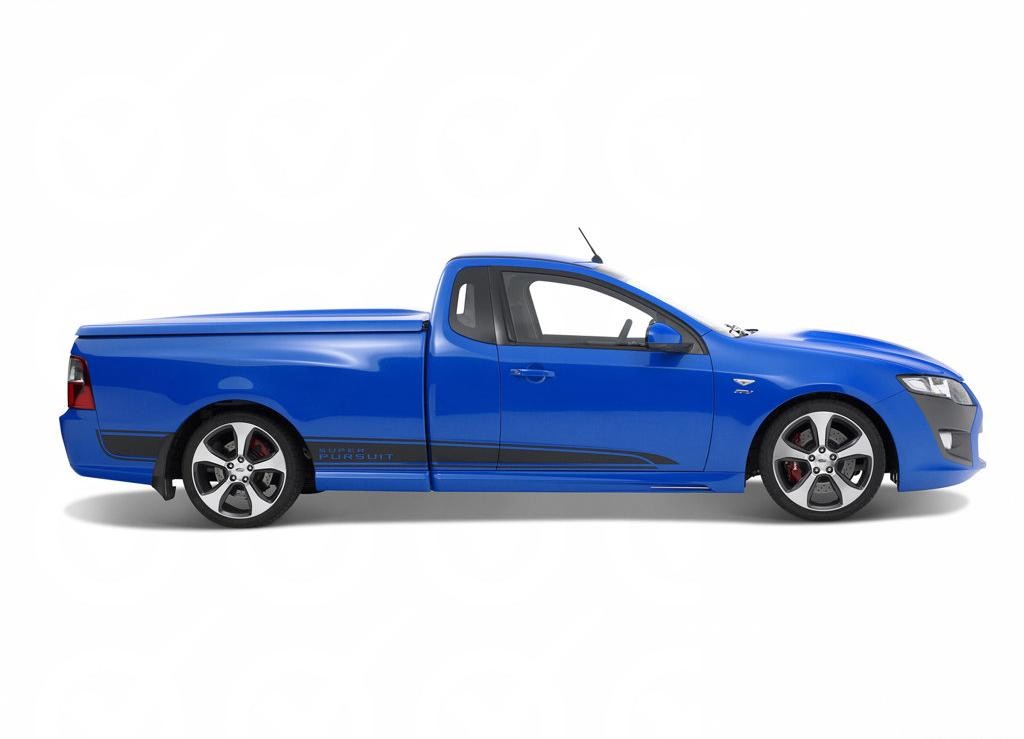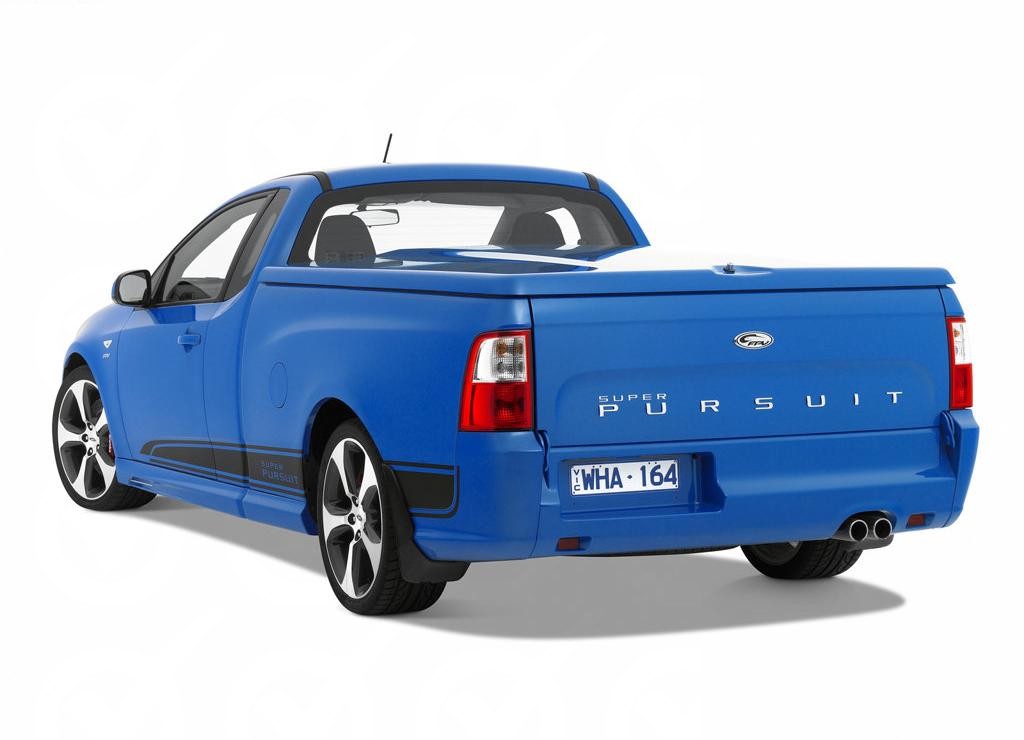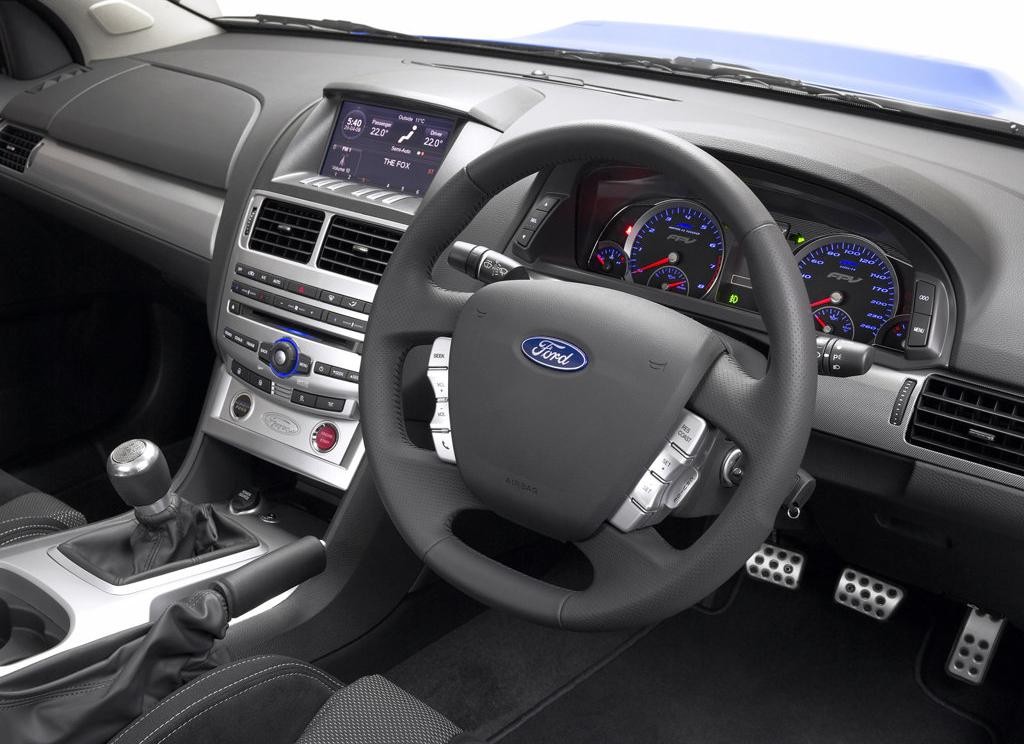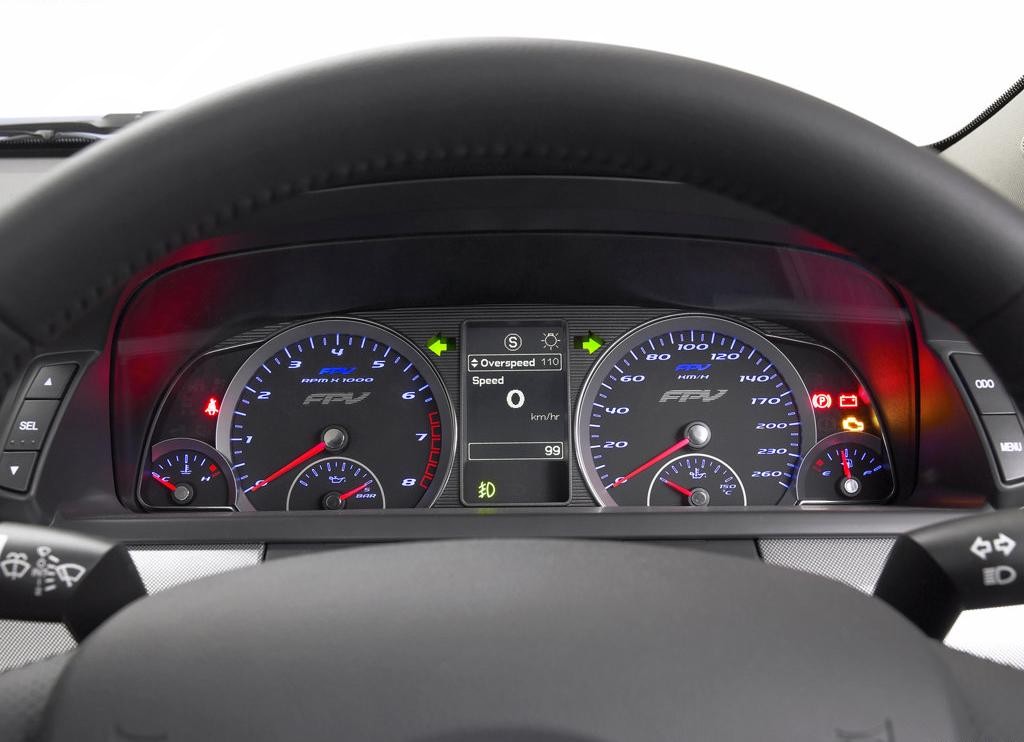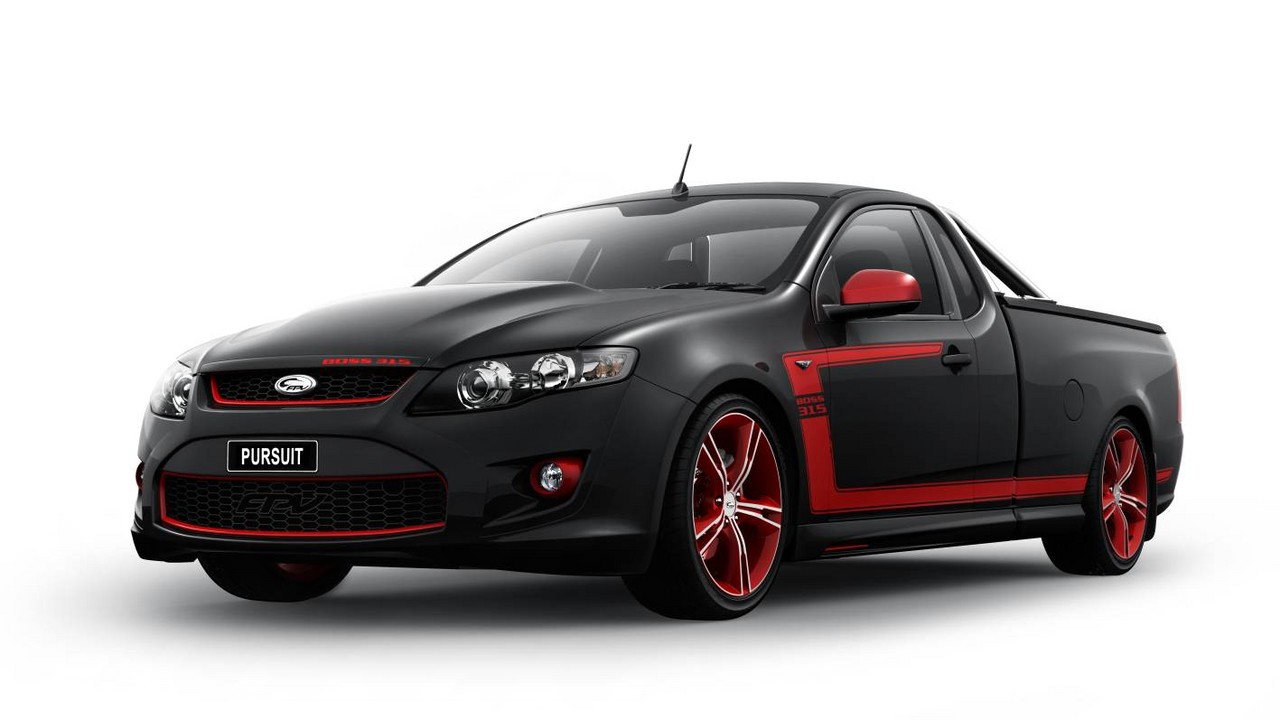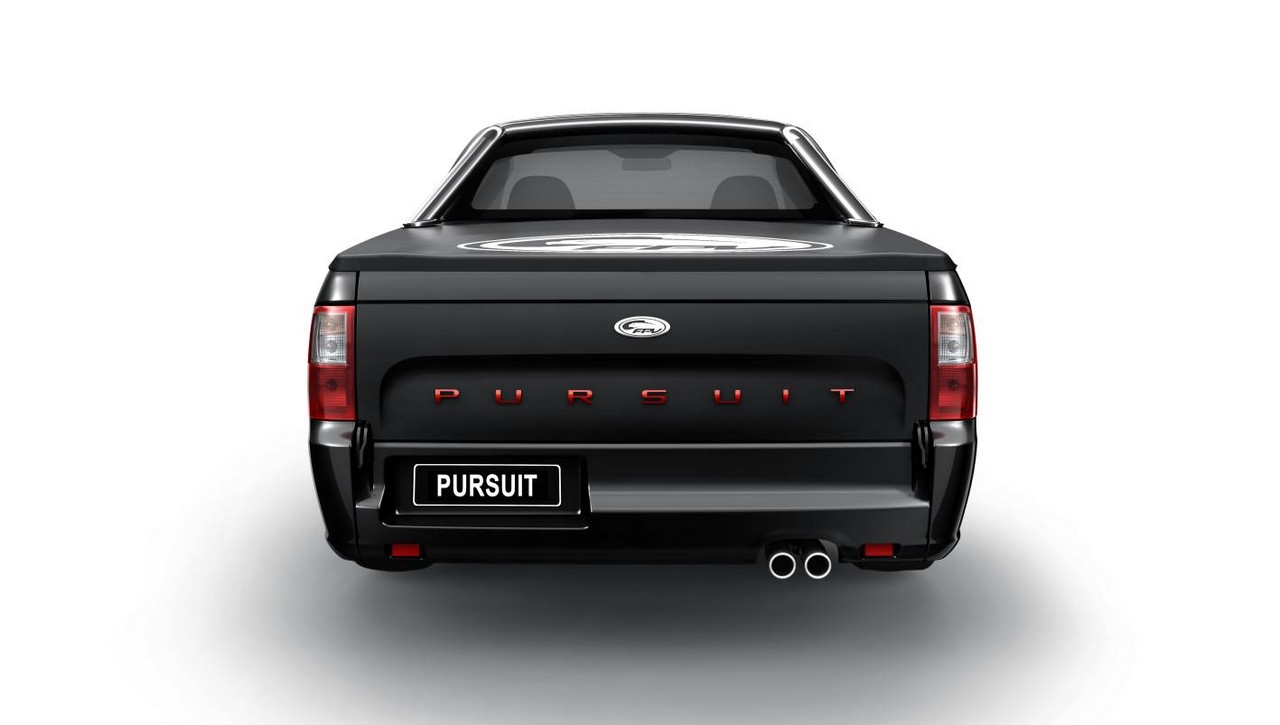
- Powerful ‘Boss 315’ V8 engines
- Refined six-speed ZF automatic transmission
- Accurate, well-weighted steering
- Powerful Brembo brakes
- Generally impressive dynamics…
- … but leaf spring rear suspension struggles for traction on uneven surfaces
- For ZF transmission, coolant lines in heat exchanger were susceptible to failure
- Awkward driving position
- Prone to drivetrain clunks
Review: FPV FG.I Pursuit (2008-10)
Overview
Released in May 2008, the FPV FG Mk.I (FG.I) Pursuit was a rear-wheel drive, performance utility. Manufactured in Campbellfield, Victoria, the FG Pursuit was powered by a 5.4-litre V8 petrol engine that was mated to either a six-speed automatic or manual transmission. The FG.I Pursuit was discontinued in 2010 when the 5.4-litre V8 engine was phased out of production due to Euro IV emissions standards.
5.4-litre Boss 315 V8 engine
The 5.4-litre Boss 315 V8 petrol engine had a cast iron block, cast aluminium cylinder head, forged steel crankshaft, cross-bolted main bearing caps, sintered connecting rods, double overhead camshafts (DOHC) per cylinder bank, roller finger followers, four valves per cylinder, twin knock sensors, coil on plug ignition and a compression ratio of 11.0:1. Compared to the Boss 302 V8 engine , the Boss 315 engine had:
- New camshaft timing and profile for higher lift and extended duration;
- Stronger pistons;
- An increased compression ratio (to 11.0:1, previously 10.5:1);
- A twin-plate throttle body to reduce pressure loss through the induction system;
- A new upper intake manifold plenum chamber for improved air flow;
- A new exhaust manifold;
- A new high flow, ‘straight-through’ twin exhaust system with new stainless steel exhaust manifolds;
- Higher peak engine speed of 6500 rpm (previously 6000 rpm);
- A new windage tray which reduced crankshaft windage losses; and,
- A new oil pan.
Transmissions
The FPV Pursuit was available with six-speed Tremec TR6060 manual or six-speed ZF 6HP26 automatic transmissions.
Replacing the Tremec T56 manual transmission, the Tremec TR6060 had triple synchromesh on first and second gears and double synchromesh on all other gears (including revrese) which reduced gear shift efforts and shift travel. The reduced shift travel also provided increased space for the use of larger, stronger gears for greater durability.
The FPV Pursuit was fitted with the high-performance ZF 6HP26 transmission which was rated for 600 Nm applications and had upgraded clutches with extra plates in the clutch packs. For the FG range, the 6HP26 transmission had a cylinder cut function whereby the fuel injectors would be deactivated during gearshifts to reduce shift times.
Development
Developed in conjunction with the FG Falcon Ute , the FPV Pursuit had:
- A stronger body structure which made increased use of high-strength steels and ultra high-strength Boron steel and included a new front subframe, additional reinforcement inside the front rails, new high strength floor cross members, transmission tunnel reinforcement and a larger, stronger B-pillar;
- New Virtual Pivot Control Link front suspension (described below);
- A forward-mounted, Y-shaped steering rack with variable-ratio steering gear;
- Upgraded static sealing and triple-sealed doors;
- Larger, 81 litre fuel tanks; and,
- A self-adjusting park brake.
Dimensions
Compared to the BF Pursuit , the FG Pursuit was 19 mm longer (at 5096 mm), 63 mm wider (1933 mm), 34 mm lower (1481 mm) and had a 4 mm longer wheelbase (3100 mm); kerb weight was approximately 1790 kg.
Suspension
The FG Pursuit had ‘Virtual Pivot Control Link’ front suspension which consisted of double wishbone front suspension (with two lower ball joints, an upper A-arm and virtual pivot lower control links) and a live rear axle suspended by leaf springs (both with gas-filled dampers and anti-roll bars).
The FG Pursuit’s double wishbone front suspension had two lower ball joints that connected the separate lower arms to the suspension knuckle. These two lower links created a virtual pivot of the lower arm – hence the ‘Virtual Pivot Control Link’ name – and allowed the suspension to behave as though the lower pivot point was at the intersection of the two arms. Due to the use of aluminium and high strength steels, the Virtual Pivot Control Link suspension was 22 kg lighter than that in the BF Pursuit .
At the rear, the Hotchkiss rear suspension consisted of a live rear axle with leaf springs. For the FG utility range, the rear suspension was revised with stiffened three-pin leaf spring shackles.
| Engine | Years | Trans. | Peak power | Peak torque | |
|---|---|---|---|---|---|
| Pursuit | 5.4-litre Boss 315 petrol V8 | 2008-10 | 6sp auto, 6sp man. |
315 kW at 6500 rpm | 551 Nm at 4750 rpm |
Safety equipment
Standard safety equipment for the FPV FG Pursuit included dual front airbags, seat-mounted head/thorax-protecting side airbags, ABS, brake assist, electronic brake force distribution, electronic stability control, traction control and front seatbelts with pretensioners and load limiters.
Brakes
The FPV FG Pursuit had 355 mm by 32 mm cross-drilled and ventilated front brake discs with four-piston Brembo calipers and 328 mm by 26 mm cross-drilled and ventilated rear discs with single-piston calipers.
As an extra-cost option, the Pursuit was available with a premium braking package which added six-piston Brembo front calipers.
ANCAP crash testing
In ANCAP crash testing , a similarly equipped FG Falcon Ute – with dual front airbags and seat-mounted head/thorax side airbags – received a five star adult occupant protection rating with a score of 33.58 out of 37. In the offset crash test, there was a slight risk of serious chest injury for the front occupants and a slight risk of serious lower leg injury for the passenger. In the side impact test, there was a slight risk of serious chest injury.
Features
Standard features for the FPV FG Pursuit included 19-inch alloy wheels with 245/35 ZR19 Dunlop Sport Maxx tyres, a four speaker sound system with a six-disc CD player and auxiliary inputs (MP3/iPod), climate control air conditioning, a seven-inch colour display, four-way power adjustable cloth seats, cruise control with speed alert, Bluetooth connectivity, automatic headlights, a leather-wrapped steering wheel, remote central locking, power mirrors and windows, a tilt and reach adjustable steering wheel, 12 volt power outlet, trip computer, a soft tonneau cover and an immobiliser.
Brochure
Related links
Review: FPV FG.II Pursuit (2012, 2014)
Overview
In August 2012, the FG.II Pursuit returned for a limited production run of seventy-five (75) R-Spec variants. Despite its name, however, the FG.II Pursuit R-Spec was based on the FG.II GS Ute . Visually, the Pursuit R-Spec could be identified by its five-spoke alloy wheels with ‘Vixen’ accents, GT colour-coded bumper, ‘Vixen’ upper and lower grille surrounds, fog lamp bezels, door mirror caps, decals and black-painted exhaust tips.
5.0-litre Boss 315 V8 engine
Developed in Australia by Prodrive at a cost of $36 million, the 5.0-litre V8 ‘Boss 315’ Miami V8 engine was based on Ford’s naturally aspirated Coyote V8 engine that was introduced in the 2010 Ford Mustang GT. The hand-built ‘Boss 315’ Miami V8 engine had an aluminium block and cylinder head, an HTV 1900 supercharger (developed by Harrop Engineering and using Eaton Twin Vortices Series technology) providing maximum boost pressure of 0.34 bar (4.93 psi), a forged steel crankshaft, powder sintered forged connecting rods, double overhead camshafts, variable intake camshaft timing, roller finger followers, four valves per cylinder, and a compression ratio of 9.25:1. Due to its aluminium construction, the supercharged Miami V8 engine was 47kg lighter than its Boss 315 predecessor.
Transmissions
For the supercharged Boss 315 engine,
- The TR6060 transmission was fitted with a new bell-housing to suit a new twin-plate clutch system (shared with the Mustang GT500) and revised second gear synchros were implemented; and,
- The 6HP26 transmission was upgraded with a new 7-plate clutch pack and 4-planet planetary gearset for improved torque capacity.
| Engine | Years | Trans. | Peak power | Peak torque | |
|---|---|---|---|---|---|
| Pursuit R-Spec | 5.0-litre s/charged Miami petrol V8 | 2012 | 6sp man., 6sp auto |
315 kW at 5750 rpm | 545 Nm at 2000-5500 rpm |
| Pursuit | 5.0-litre s/charged Miami petrol V8 | 2014 | 6sp man., 6sp auto |
315 kW at 5750 rpm | 545 Nm at 2000-5500 rpm |
Features: Pursuit R-Spec
Compared to the FG.II GS Ute , the R-Spec featured eight-inch wide rear tyres, a premium sound system, ‘Shadow’ leather sports seats and piano black interior finishes.
2014 FPV Pursuit Ute
In June 2014, the Pursuit was released in a limited production run of 120 units. Compared to the FG.II GS Ute , the Pursuit Ute was distinguished by its eight-inch GT wheels with five-spoke alloy wheel design, premium sound system, satellite navigation system, climate control, partial leather seats, ‘Pursuit’ badging and build number badge.
Visual cues for the Pursuit included a GT front bumper, F6 side skirts, GT wheels and a ‘stealth’ stripe design package which, according to Ford, was ‘evocative of the blacked-out headlights from Ford muscle cars of the 70s’. Available in Winter White, Kinetic (blue), Silhouette (black), Octane (orange) and Smoke (dark grey) paint finishes, the Pursuit Ute featured standard matte black stripes for all colours, with a ‘performance white’ option for the Kinetic finish and metallic gold for Silhouette; silver strip options were also available for the Smoke and Silhouette finishes.
Brochures
- Brochure: FPV FG.II GT R-Spec and Pursuit R-Spec (August 2012)
- Brochure: FPV FG.II Pursuit (July 2014)
Related links
